David R. Bull
Department of Electrical and Electronic Engineering, University of Bristol
ST-MFNet Mini: Knowledge Distillation-Driven Frame Interpolation
Feb 23, 2023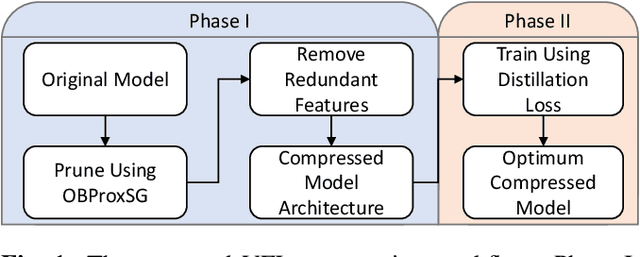
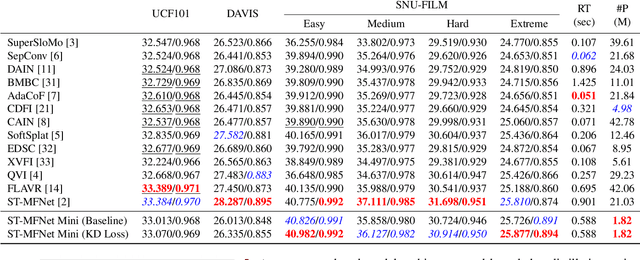


Abstract:Currently, one of the major challenges in deep learning-based video frame interpolation (VFI) is the large model sizes and high computational complexity associated with many high performance VFI approaches. In this paper, we present a distillation-based two-stage workflow for obtaining compressed VFI models which perform competitively to the state of the arts, at a greatly reduced model size and complexity. Specifically, an optimisation-based network pruning method is first applied to a recently proposed frame interpolation model, ST-MFNet, which outperforms many other VFI methods but suffers from large model size. The resulting new network architecture achieves a 91% reduction in parameters and 35% increase in speed. Secondly, the performance of the new network is further enhanced through a teacher-student knowledge distillation training process using a Laplacian distillation loss. The final low complexity model, ST-MFNet Mini, achieves a comparable performance to most existing high-complex VFI methods, only outperformed by the original ST-MFNet. Our source code is available at https://github.com/crispianm/ST-MFNet-Mini
Deep VQA based on a Novel Hybrid Training Methodology
Feb 17, 2022Abstract:In recent years, deep learning techniques have been widely applied to video quality assessment (VQA), showing significant potential to achieve higher correlation performance with subjective opinions compared to conventional approaches. However, these methods are often developed based on limited training materials and evaluated through cross validation, due to the lack of large scale subjective databases. In this context, this paper proposes a new hybrid training methodology, which generates large volumes of training data by using quality indices from an existing perceptual quality metric, VMAF, as training targets, instead of actual subjective opinion scores. An additional shallow CNN is also employed for temporal pooling, which was trained based on a small subjective video database. The resulting Deep Video Quality Metric (based on Hybrid Training), DVQM-HT, has been fully tested on eight HD subjective video databases, and consistently exhibits higher correlation with perceptual quality compared to other deep quality assessment methods, with an average SROCC value of 0.8263.
Perceptually-inspired super-resolution of compressed videos
Jun 15, 2021Abstract:Spatial resolution adaptation is a technique which has often been employed in video compression to enhance coding efficiency. This approach encodes a lower resolution version of the input video and reconstructs the original resolution during decoding. Instead of using conventional up-sampling filters, recent work has employed advanced super-resolution methods based on convolutional neural networks (CNNs) to further improve reconstruction quality. These approaches are usually trained to minimise pixel-based losses such as Mean-Squared Error (MSE), despite the fact that this type of loss metric does not correlate well with subjective opinions. In this paper, a perceptually-inspired super-resolution approach (M-SRGAN) is proposed for spatial up-sampling of compressed video using a modified CNN model, which has been trained using a generative adversarial network (GAN) on compressed content with perceptual loss functions. The proposed method was integrated with HEVC HM 16.20, and has been evaluated on the JVET Common Test Conditions (UHD test sequences) using the Random Access configuration. The results show evident perceptual quality improvement over the original HM 16.20, with an average bitrate saving of 35.6% (Bj{\o}ntegaard Delta measurement) based on a perceptual quality metric, VMAF.
An adaptive Lagrange multiplier determination method for rate-distortion optimisation in hybrid video codecs
Jun 15, 2021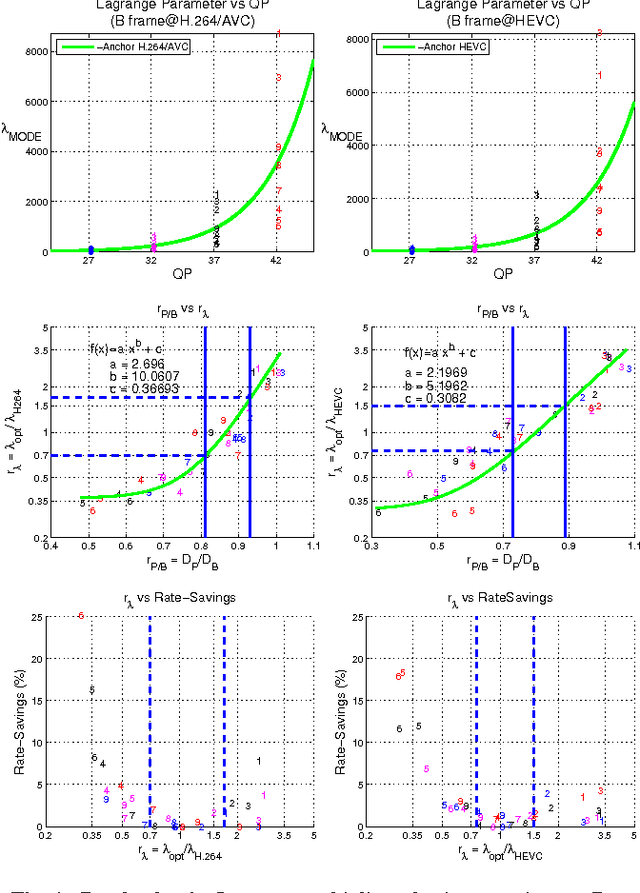


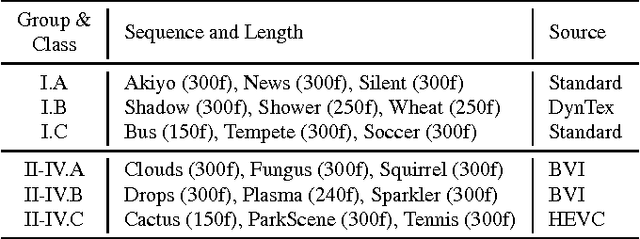
Abstract:This paper describes an adaptive Lagrange multiplier determination method for rate-quality optimisation in video compression. Inspired by the experimental results of a Lagrange multiplier selection test, the presented approach adaptively estimates the optimum Lagrange multiplier for different video content, based on distortion statistics of recently encoded frames. The proposed algorithm has been fully integrated into both the H.264 and HEVC reference codecs, and is used in rate-distortion optimisation for encoding B frames. The results show promising (up to 11% on the sequences tested) overall bitrate savings, for a minimal increase in complexity, on various types of test content based on Bjontegaard delta measurements.
Quality assessment methods for perceptual video compression
Jun 15, 2021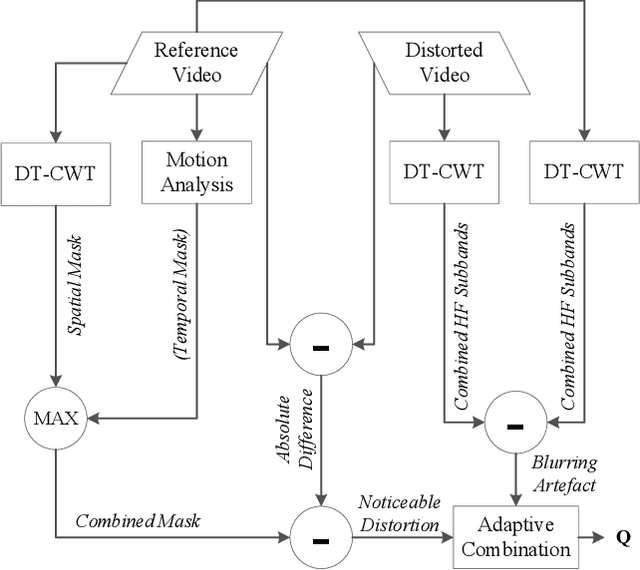
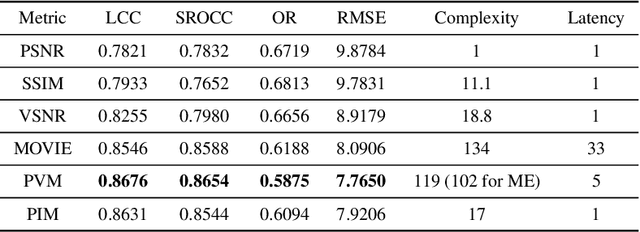

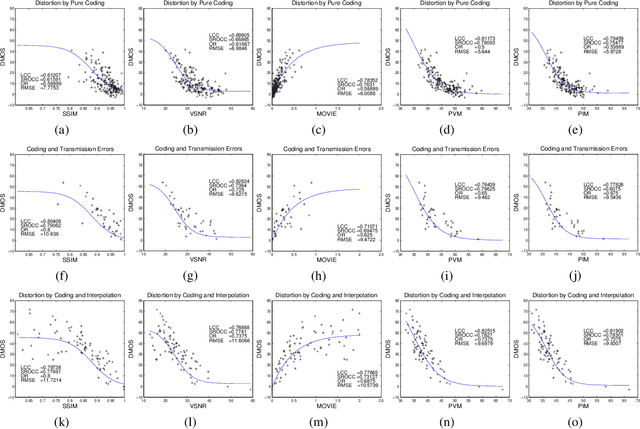
Abstract:This paper describes a quality assessment model for perceptual video compression applications (PVM), which stimulates visual masking and distortion-artefact perception using an adaptive combination of noticeable distortions and blurring artefacts. The method shows significant improvement over existing quality metrics based on the VQEG database, and provides compatibility with in-loop rate-quality optimisation for next generation video codecs due to its latency and complexity attributes. Performance comparison are validated against a range of different distortion types.
VMAF-based Bitrate Ladder Estimation for Adaptive Streaming
Mar 12, 2021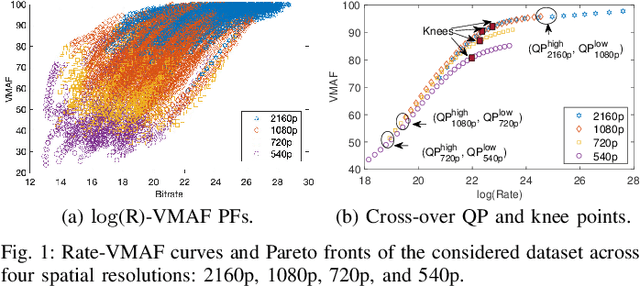
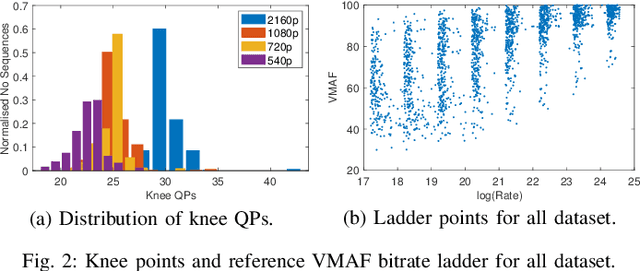
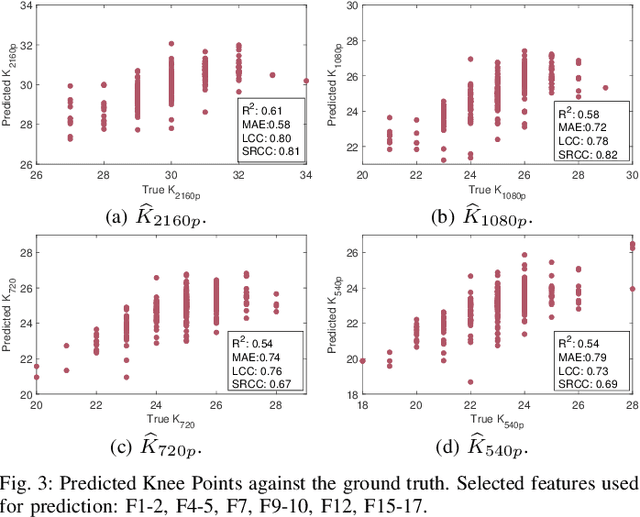
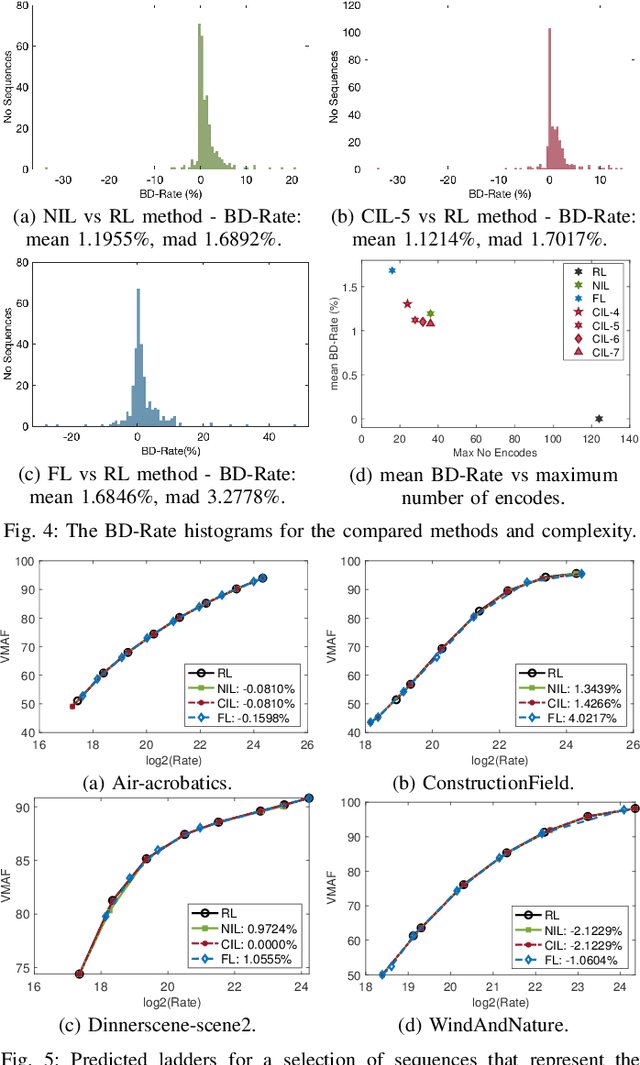
Abstract:In HTTP Adaptive Streaming, video content is conventionally encoded by adapting its spatial resolution and quantization level to best match the prevailing network state and display characteristics. It is well known that the traditional solution, of using a fixed bitrate ladder, does not result in the highest quality of experience for the user. Hence, in this paper, we consider a content-driven approach for estimating the bitrate ladder, based on spatio-temporal features extracted from the uncompressed content. The method implements a content-driven interpolation. It uses the extracted features to train a machine learning model to infer the curvature points of the Rate-VMAF curves in order to guide a set of initial encodings. We employ the VMAF quality metric as a means of perceptually conditioning the estimation. When compared to exhaustive encoding that produces the reference ladder, the estimated ladder is composed by 74.3% of identical Rate-VMAF points with the reference ladder. The proposed method offers a significant reduction of the number of encodes required, 77.4%, at a small average Bj{\o}ntegaard Delta Rate cost, 1.12%.
Efficient Bitrate Ladder Construction for Content-Optimized Adaptive Video Streaming
Feb 08, 2021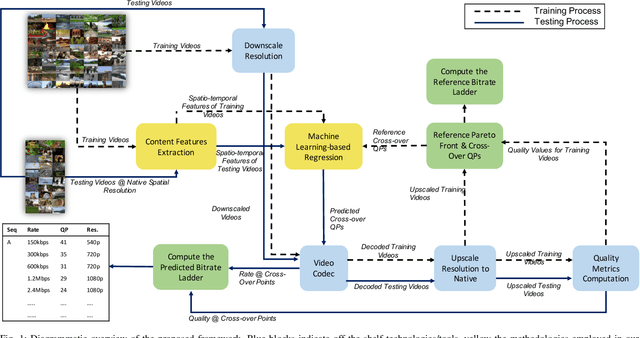
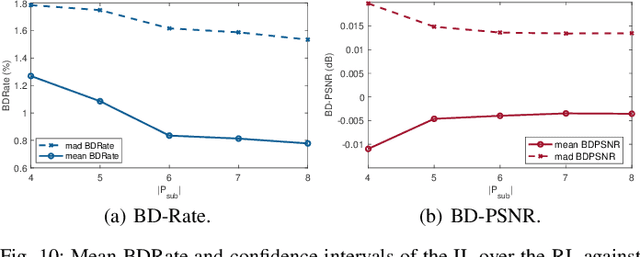

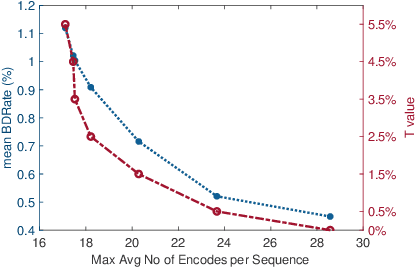
Abstract:One of the challenges faced by many video providers is the heterogeneity of network specifications, user requirements, and content compression performance. The universal solution of a fixed bitrate ladder is inadequate in ensuring a high quality of user experience without re-buffering or introducing annoying compression artifacts. However, a content-tailored solution, based on extensively encoding across all resolutions and over a wide quality range is highly expensive in terms of computational, financial, and energy costs. Inspired by this, we propose an approach that exploits machine learning to predict a content-optimized bitrate ladder. The method extracts spatio-temporal features from the uncompressed content, trains machine-learning models to predict the Pareto front parameters, and, based on that, builds the ladder within a defined bitrate range. The method has the benefit of significantly reducing the number of encodes required per sequence. The presented results, based on 100 HEVC-encoded sequences, demonstrate a reduction in the number of encodes required when compared to an exhaustive search and an interpolation-based method, by 89.06% and 61.46%, respectively, at the cost of an average Bj{\o}ntegaard Delta Rate difference of 1.78% compared to the exhaustive approach. Finally, a hybrid method is introduced that selects either the proposed or the interpolation-based method depending on the sequence features. This results in an overall 83.83% reduction of required encodings at the cost of an average Bj{\o}ntegaard Delta Rate difference of 1.26%.
Study of Compression Statistics and Prediction of Rate-Distortion Curves for Video Texture
Feb 08, 2021



Abstract:Encoding textural content remains a challenge for current standardised video codecs. It is therefore beneficial to understand video textures in terms of both their spatio-temporal characteristics and their encoding statistics in order to optimize encoding performance. In this paper, we analyse the spatio-temporal features and statistics of video textures, explore the rate-quality performance of different texture types and investigate models to mathematically describe them. For all considered theoretical models, we employ machine-learning regression to predict the rate-quality curves based solely on selected spatio-temporal features extracted from uncompressed content. All experiments were performed on homogeneous video textures to ensure validity of the observations. The results of the regression indicate that using an exponential model we can more accurately predict the expected rate-quality curve (with a mean Bj{\o}ntegaard Delta rate of 0.46% over the considered dataset) while maintaining a low relative complexity. This is expected to be adopted by in the loop processes for faster encoding decisions such as rate-distortion optimisation, adaptive quantization, partitioning, etc.
CVEGAN: A Perceptually-inspired GAN for Compressed Video Enhancement
Nov 26, 2020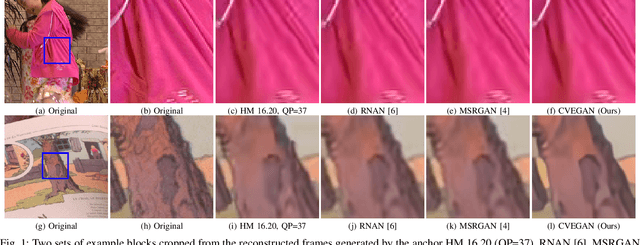

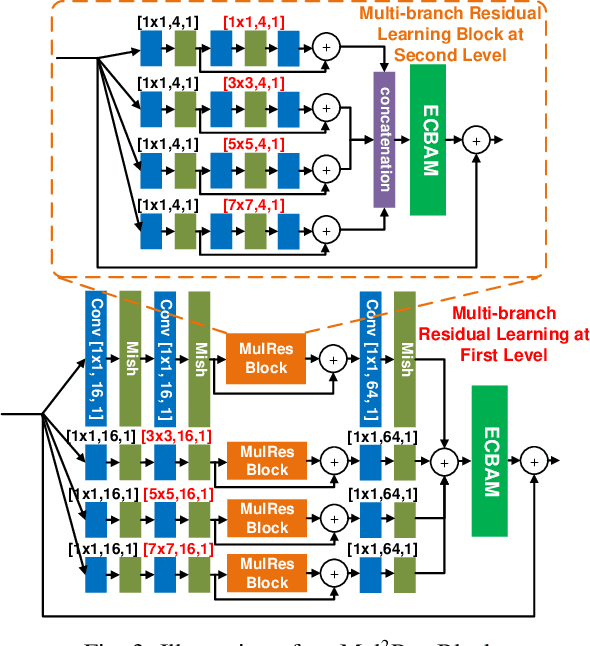
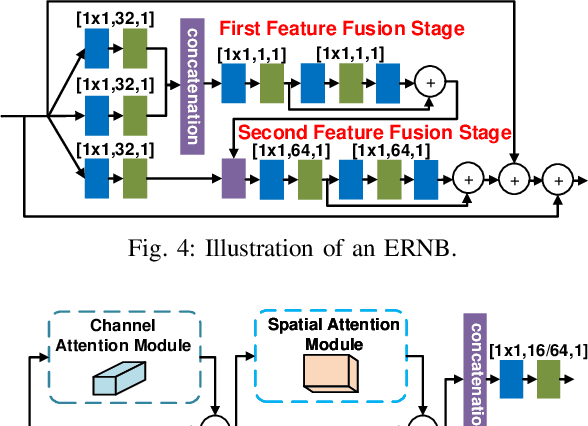
Abstract:We propose a new Generative Adversarial Network for Compressed Video quality Enhancement (CVEGAN). The CVEGAN generator benefits from the use of a novel Mul2Res block (with multiple levels of residual learning branches), an enhanced residual non-local block (ERNB) and an enhanced convolutional block attention module (ECBAM). The ERNB has also been employed in the discriminator to improve the representational capability. The training strategy has also been re-designed specifically for video compression applications, to employ a relativistic sphere GAN (ReSphereGAN) training methodology together with new perceptual loss functions. The proposed network has been fully evaluated in the context of two typical video compression enhancement tools: post-processing (PP) and spatial resolution adaptation (SRA). CVEGAN has been fully integrated into the MPEG HEVC video coding test model (HM16.20) and experimental results demonstrate significant coding gains (up to 28% for PP and 38% for SRA compared to the anchor) over existing state-of-the-art architectures for both coding tools across multiple datasets.
Video Compression with CNN-based Post Processing
Sep 16, 2020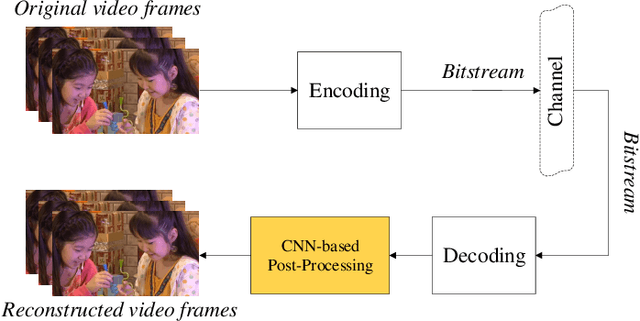
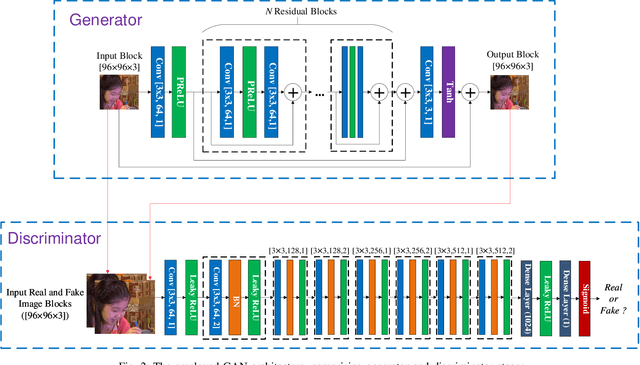
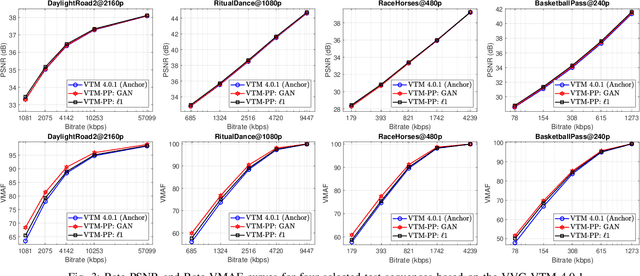
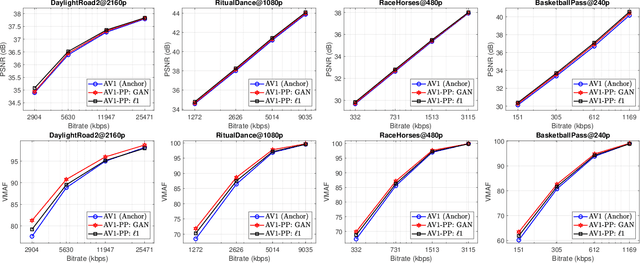
Abstract:In recent years, video compression techniques have been significantly challenged by the rapidly increased demands associated with high quality and immersive video content. Among various compression tools, post-processing can be applied on reconstructed video content to mitigate visible compression artefacts and to enhance overall perceptual quality. Inspired by advances in deep learning, we propose a new CNN-based post-processing approach, which has been integrated with two state-of-the-art coding standards, VVC and AV1. The results show consistent coding gains on all tested sequences at various spatial resolutions, with average bit rate savings of 4.0% and 5.8% against original VVC and AV1 respectively (based on the assessment of PSNR). This network has also been trained with perceptually inspired loss functions, which have further improved reconstruction quality based on perceptual quality assessment (VMAF), with average coding gains of 13.9% over VVC and 10.5% against AV1.
 Add to Chrome
Add to Chrome Add to Firefox
Add to Firefox Add to Edge
Add to Edge